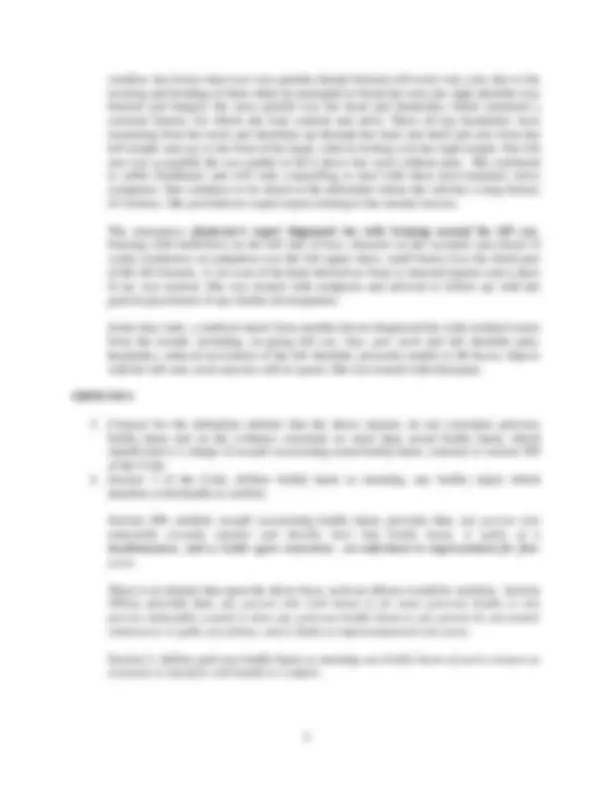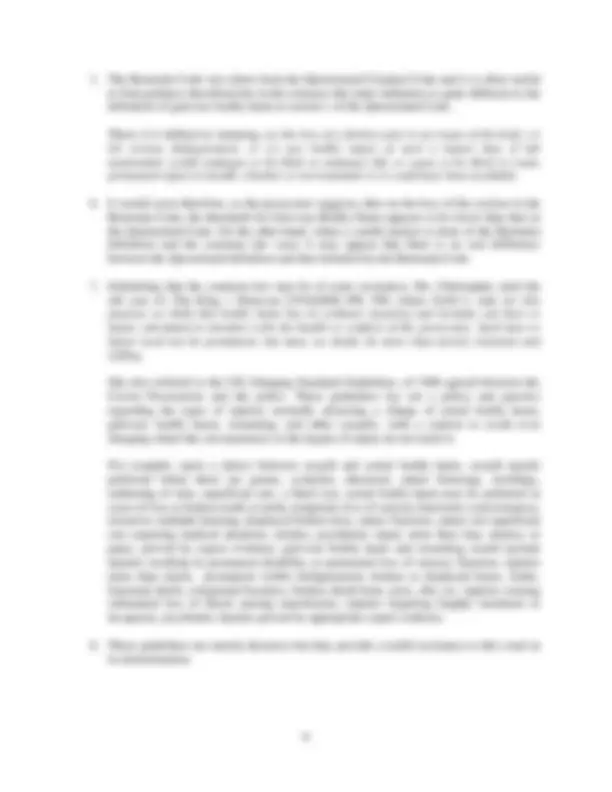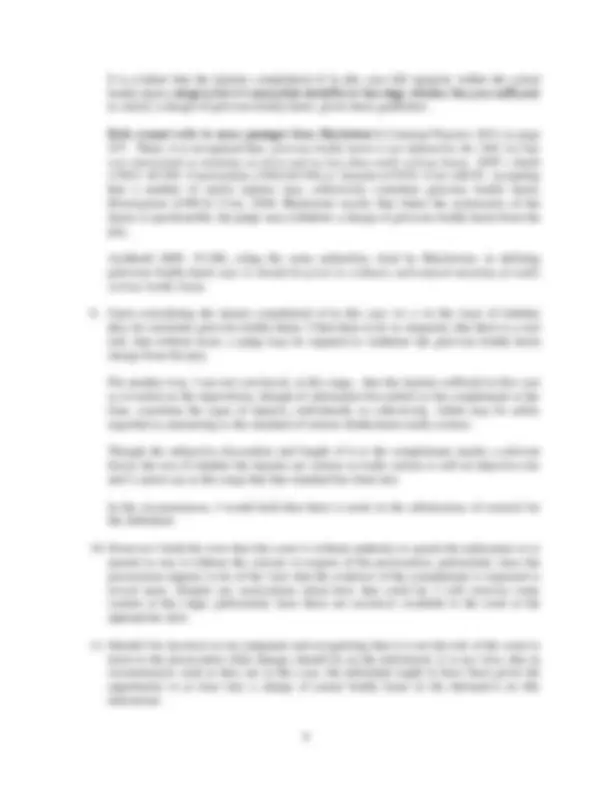





Study with the several resources on Docsity

Earn points by helping other students or get them with a premium plan


Prepare for your exams
Study with the several resources on Docsity

Earn points to download
Earn points by helping other students or get them with a premium plan
Community
Ask the community for help and clear up your study doubts
Discover the best universities in your country according to Docsity users
Free resources
Download our free guides on studying techniques, anxiety management strategies, and thesis advice from Docsity tutors
A legal analysis of a Motion seeking to quash indictments for grievous bodily harm with intent and unlawful deprivation of liberty in Bermuda. the definitions of bodily harm and grievous bodily harm under the Criminal Code Act 1907 and compares it to the Queensland Code. The analysis also covers the common law cases and guidelines for determining the types of injuries for different assault charges.
Typology: Slides
1 / 7

This page cannot be seen from the preview
Don't miss anything!




[2014] SC (Bda) 96 Crim (5 December 2014)
2014: No. 34
THE QUEEN Applicant
and
STEVE B. SYMONDS Defendant
(In Court)
Date of Hearing: 5 th^ December, 2014 Date of Judgment: 5 th^ December, 2014
Mr. Carrington Mahoney, Department of Public Prosecutions and Ms. Kenlyn Swan for the Crown Ms. Elizabeth Christopher and Mr. Arion Mapp for the Defendant
THE FACTS
The evidence in the depositions is that the defendant was the respondent in certain divorce proceedings and the complainant was the attorney for petitioner. The defendant failed to comply with an ancillary order and upon further application by the complainant on behalf of the petitioner, the judge, in chambers, granted an order that the respondent pay to the petitioner, a sum of $60,000 within a number of days or the judgment was to be satisfied against a house owned by the respondent in an overseas jurisdiction. Apparently a further order was also sought or made for the defendant to pay costs of $35,000.
Upon demitting the judge’s chambers, the defendant, upset by the result of the proceedings, attacked the complainant. He grabbed her by the neck, choked her, threw her to the ground, straddled her, hit her head against the ground and with his fist, delivered several blows to her, including to her face, until he was pulled off her by several witnesses. She was shortly thereafter taken to the hospital by ambulance where she was attended by a physician.
The complainant, in a statement, bearing a certificate in accordance with the Indictable Offences Act, made the same day, said she was diagnosed with multiple facial contusions, left side peri-orbital hematoma, soft tissue injury to her left upper chest, sprained left wrist and massive headache.
In a further statement some days later, not bearing the certificate, she added that she continued to suffer pain and suffering, her left eye had been completely closed for a number of days and was now opening again and was very painful, the side of her face was bruised, swollen and very painful, her jaw was so painful, it required her to eat soft food for days, her neck and throat were so inflamed and sore it made it painful to
5. The Bermuda Code was taken from the Queensland Criminal Code and it is often useful to find guidance therefrom but in this instance this latter definition is quite different to the definition of grievous bodily harm at section 1 of the Queensland Code.
There, it is defined as meaning , (a) the loss of a distinct part or an organ of the body; or (b) serious disfigurement; or (c) any bodily injury of such a nature that, if left unattended, would endanger or be likely to endanger life, or cause or be likely to cause permanent injury to health; whether or not treatment is or could have been available.
She also referred to the UK Charging Standard Guidelines, of 1996 agreed between the Crown Prosecution and the police. These guidelines lay out a policy and practice regarding the types of injuries normally attracting a charge of actual bodily harm, grievous bodily harm, wounding, and other assaults, with a caution to avoid over charging where the circumstances or the degree of injury do not merit it.
For example, upon a choice between assault and actual bodily harm, assault maybe preferred where there are grazes, scratches, abrasions, minor bruisings, swellings, reddening of skin, superficial cuts, a black eye; actual bodily harm may be preferred in cases of loss or broken tooth or teeth, temporary loss of sensory functions/ consciousness, extensive multiple bruising, displaced broken nose, minor fractures, minor not superficial cuts requiring medical attention, stitches, psychiatric injury more than fear, distress or panic, proved by expert evidence; grievous bodily harm and wounding would include injuries resulting in permanent disability or permanent loss of sensory function, injuries more than minor, permanent visible disfigurement, broken or displaced bones, limbs, fractured skulls, compound fractures, broken cheek bone, jaws, ribs, etc, injuries causing substantial loss of blood causing transfusions, injuries requiring lengthy treatment or incapacity, psychiatric injuries proved by appropriate expert evidence.
It is evident that the injuries complained of in this case fall squarely within the actual bodily harm category but it’s somewhat doubtful at this stage whether they are sufficient to satisfy a charge of grievous bodily harm, given those guidelines.
Both counsel refer to some passages from Blackstone’s Criminal Practice 2012 at page
Archbold 2009, 19-206, citing the same authorities cited by Blackstone, in defining grievious bodily harm says, it should be given its ordinary and natural meaning of really serious bodily harm.
Put another way, I am not convinced, at this stage, that the injuries suffered in this case as revealed on the depositions, though of substantial discomfort to the complainant at the time, constitute the types of injuries, individually or collectively, which may be safely regarded as amounting to the standard of serious-furthermore really serious.
Though the subjective discomfort and length of it to the complainant maybe a relevant factor, the test of whether the injuries are serious or really serious is still an objective one and I cannot say at this stage that that standard has been met.
In the circumstances, I would hold that there is merit in the submissions of counsel for the defendant.
Her comparison of it to the offenses of kidnapping and false imprisonment does not assist her.
This offense was ideally created and suited to situations as illustrated in these depositions. There is no prejudice to the defendant. In the end, if he is convicted of both offences, it will be for a judge to decide, on totality and proportionality principles, what sentence he should receive.
Once the prosecution has sufficient evidence to indict on such a charge, the court is without any power to quash the indictment or, I think as it is in this case, stay the indictment. I think that point is illustrated in The Queen v Durant and Gardiner. No: 2 of 2006.
There is no definition in the Code for deprivation of liberty and the offence is unknown to the common law, but assistance can be found at Carter’s Criminal Law of Queensland, 19 th^ Edition, where it is stated that its’ meaning can be gleaned from the ordinary meaning of the words in section 355 of the Queensland Code. That section is identical to section 321 of the Bermuda Code, which provides, Any person who unlawfully confines or detains another in any place against the other person’s will, or otherwise unlawfully deprives another person of his personal liberty, is guilty of a misdemeanour, and is liable on conviction on an indictment to imprisonment for seven years.
The terms, confines, detains, deprives and liberty should each be given their ordinary and natural meaning….liberty as defined in the Oxford English dictionary is, the condition of being able to act in any desired way without restraint; power to do as one likes…deprive, is defined as including denial of enjoyment of something, and detain, has a variety of meanings, including, keep in confinement, hold back, delay, stop.
On the depositions this is exactly what the defendant did to the complainant. There is no merit in this ground. It is dismissed.
Carlisle Greaves, .PJ. 5 th^ December 2014